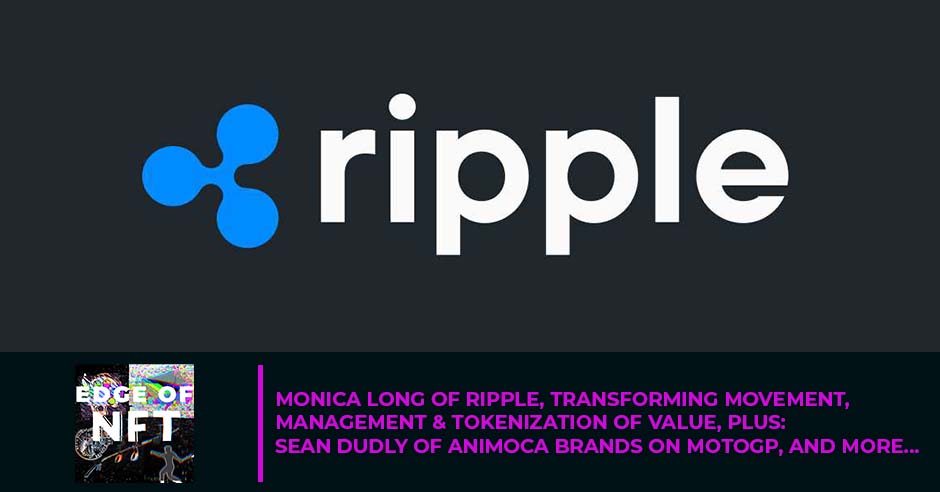
Globally recognized as a platform that builds breakthrough crypto solutions for a world without economic borders, Ripple is a household name in the intersection of blockchain and fintech. Monica Long has been with Ripple early on and now currently serves as its General Manager. She has seen how the company built itself into the world’s leading enterprise blockchain and crypto solutions provider by pioneering innovative solutions to international money transfers, central bank digital currencies, and decentralized financial services. In this episode, she talks about these, as well as recent developments, particularly the XLS-20 standard and how it benefits developers and creators. Meanwhile, Sean Dudley, VP of Product at Animoca Brands, joins in on the conversation to talk a little bit about the upcoming MotoGP Ignition Champions. Tune in and get a view of the future that’s already happening in the present, both in fintech and gaming, right here on the Edge of NFT.
—
Listen to the podcast here
Monica Long Of Ripple, Transforming Movement, Management & Tokenization Of Value, Plus: Sean Dudly Of Animoca Brands On MotoGP, And More…
Stay tuned for this episode and find out how Ripple continues to empower the masses to bank in a decentralized world and is set to roll out some dope new NFT tech.
Additionally, what’s the story behind our guest’s SpaceX artwork on her wall.
Also, on how to get into the next wave of your new gaming obsession through MotoGP. All this and more on this episode. Enjoy.
—
This episode features Monica Long, who is the GM of Ripple, the leading enterprise blockchain and crypto solutions company. Monica leads the team, providing infrastructure tools, services, programs, and support for the creation of the XRP Ledger to enable the internet of value, as well as the RippleNet side of the business, which works on providing frictionless global money transfer using the power of blockchain tech. Monica served as VP of Marketing, having joined Ripple in 2013 as the company’s first marketing communications hire.
Throughout her career, she’s helped tech companies drive fundamental change in the financial services industry and was recognized among the Bay Area’s Most Influential Women in Business in 2020. Monica also supports the women at Ripple Employee Resource Group as its executive sponsor. Before joining Ripple, Monica worked in corporate communications at Intuit and supported startup clients in various B2B and B2C sectors with several in FinTech, including Prosper.
—
Monica, welcome to the show.
Thank you for having me. I’m excited to be here.
It’s great to see you, Monica. Are you back at home or are you still in Texas?
I am at home. I sadly did not make the journey out to Austin. A lot of my colleagues did, and I heard it was a rock and a good time. I know we’ll talk more about it. It was also over 100 degrees.
There are a lot of record highs. There are over 17,000 individuals that consensus. I felt like we were all showering in our clothes throughout the week, but the Ripple House was a clutch haven of cool air conditioning and interesting people in the midst of all of it. I scooted over there on the first day and your team did a great job setting up an event that was accommodating and integrated into things. There’s a cool graffiti art wall. We did a little clip on our show, showing this virtual graffiti. It was a cool event.
Thank you for stopping by and visiting. It’s good to know we kept the air conditioning rolling too.
That was the most important thing. We’ll talk more, but let’s talk about you and your journey with Ripple to kick things off. We love to understand more about your origin story with Ripple. Ripple is a household name. It’s not only in the blockchain community, but globally, it goes hand in hand with people’s understanding of Bitcoin and Ethereum. It’s an important part of the ecosystem, and we would love to understand how you got into the mix there.
Thank you for giving that praise to us. I am a lucky duck. Let me say that. I entered the fray of Ripple in 2013, about a year after the company was founded. The entry point I had was in the set of Eathan, you mentioned that one of my clients when I was on the corporate communications public relations side, was Prosper. Prosper was one of the first people-to-people lending marketplaces. It was co-founded by Chris Larsen. He was also the CEO. I worked for him then and found him to be such a visionary leader, someone who truly looked at a problem in financial services around personal and small business loans and was seeking to make that whole system work more for the people. I found that to be inspiring.
I connected with that mission and with him. When he was the Cofounder of Ripple in 2012, I noticed that he had started this new project. I talked to him, and that was my introduction to crypto, Bitcoin, and this new revolution that he was talking about around digital gold and how important the internet of value would be to the future of humanity. He sold me on what this big adventure would be, so I was lucky to join then.
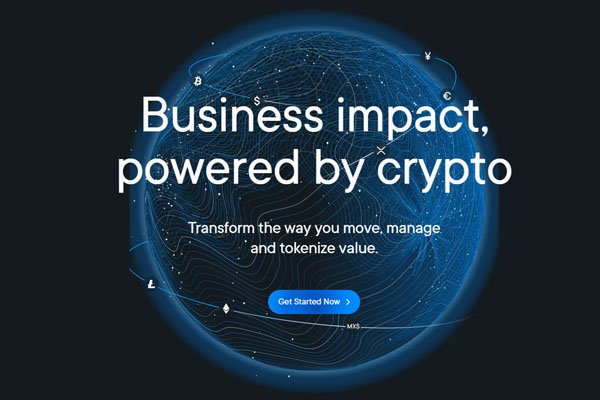
Blockchain Fintech: The XRP Ledger introduced some new innovations around tokenization so you could represent different types of value, not just the native cryptocurrency on the ledger.
That’s cool, especially since it’s been for a couple of years since then. You’re still in the mix, so there’s an energy and culture of a mission alignment there.
There’s nothing I’d rather be working on. With no other people, speaking to culture, I respect what Chris and then Brad Garlinghouse, our CEO for a number of years, on what culture, value system, and operating culture they’ve built. It’s a joy to work with the people I work with, and I’m always learning from them.
I’ve got my Prosper account. I don’t know if you guys Jeff and Josh too, but I opened one several years ago. I always liked that idea. For people who aren’t familiar, you can be a lender instead of a bank. They do interesting things like set you up with a basket of assets. You’ve got some high-risk lending, some people who got an A credit rating, and different interest rates associated with it. It’s appealing to those people who are on the FinTech side of blockchain too. They want to get in on that FinTech a little bit deeper and play a role.
The original vision the way he would describe it was he felt like lending should come back to community banking roots, like we’re neighbors, and you have car trouble. I’ll spot you, but you wanted to do that on a broader scale, first in the US and then more globally. The original form of it was borrowed from the eBay auction system. Different lenders could bid on the interest rates based on the borrower’s information. That was a people-to-people lending platform, the centralized method and now track that to decentralize finance and what the possibilities are that are so exciting to address the systemic inequities in financial services.
I got to go slightly deeper down this rabbit hole. As a musician and somebody who made my living, like an independent contractor playing music and going to the bank, they would be, “Where’s your W-2? We want to see that W-2.” Things like this are so great because it goes, “It’s all this bureaucracy. I’m going to pay it back. I’ve got the income data that doesn’t have to be on this particular type of document.“ I appreciate that movement so much.
Let’s talk a little bit more about some of these big global obstacles that are being taken on here, and you’re in the mix. Money transfer has always been a major pain, particularly international transfers. I want to know how Ripple changes that and also say I deal with that. I’m just dealing with somebody that I know is trying to make a transfer to someone in Peru. They’re trying all these different services, and they don’t make sense. Tell us what you guys got going on there.
It’s a headache. Early on, as the company was getting started in the 2013 to 2015 period, we were exploring a number of different use cases, in particular looking at XRP Ledger. XRP Ledger was one of the very first all-chains to Bitcoin. Mine launched slightly before it. It introduced some new innovations around tokenization so you could represent different types of value, not just the native cryptocurrency on the ledger. It’s a decentralized exchange, but right on the protocols. It would make it easy to trade different cryptos or tokens on the ledger.
There’s a different consensus mechanism for validation to try to make the ledger work efficiently. It’s a low fee and fast settlement at a high scale. Looking at that combination of elements, there’s something that smacks you in the face as, “This would be a good ledger for payments.” Those are the problems that we started to explore. It’s mindblowing how much money is sent around the world every year. It’s in the order of $130 trillion annually. The way that these different payment networks grew up over time was more domestically based.
If you’re trying to cross domestic systems, you require all these intermediaries to facilitate that exchange. Over time, what happened was in order for liquidity to be broad and deep enough to service global payments, very few, large banks control the FX markets. The top 5 banks control 95% of foreign exchange. You don’t have competitive pricing and open access to the foreign exchange markets. For those of us that are already down the rabbit hole of blockchain and crypto, these are things that blockchains are good at solving, creating a global fabric that is open distribution.
It’s good at connecting disparate systems and networks and making value or tokens move more efficiently across those different networks without all those intermediaries required. That’s what we started to set about solving. It’s important to note the timing at which we started doing this. 2014 to 2015 was right on the back of the Silk Road bust and Mt. Gox collapsing headline after headline about the dark web that Bitcoin is a haven for the dark web. You could put a frame that either way makes sense.
When we were walking into banks and other financial institutions to pitch them this idea of, “You should use a blockchain to solve these problems that you have with cross-border money transfers,” they weren’t open to that conversation at that time. As we started to build the software and technology to make cross-border transfers more efficient, it was focused on how we do it in a way that gives them total control over their compliance and doesn’t require the use of cryptocurrency in the transactions.
Around 2018, that changed. The whole industry was growing up so there was a lot more openness to the conversation about using crypto in cross-border transfer, which is the real thing. That’s the unlock that makes using a blockchain instead of a centralized system for cross-border money transfer ten times plus better because you can bring down costs dramatically if you’re able to use an asset like XRP, which is a global, independent type of asset. On an open ledger, like the XRP Ledger, that’s what makes those cross-border transfers 90% more efficient.
One of the things that are always tricky about dealing with new forms of money, in general, is making sure that liquidity is there and the foundation is reliable and dependable. You guys have been around a long time and have established that. Can you talk to me about what that process was like from the early days to where you are now?
Liquidity has always been at the heart of our story and the different types of solutions that we have built. In the context of RippleNet and cross-border payments, we were talking about that part of the product that uses XRP to facilitate cross-border transfers we call On-Demand Liquidity. Historically, these institutions we work with would have to pre-fund accounts internationally so that they had liquidity available in Thai Baht, Filipino peso, Mexican peso, etc., available to execute a transaction from wherever their customers wanted to send using on-demand liquidity results. They don’t have to outlay all that capital in those different markets. Instead, they can, on a transaction-by-transaction basis or in batch, create the liquidity for that transaction using XRP on demand.
Beyond that, the liquidity story has extended. We had an insight from our customer base where they increasingly want to offer crypto products to their customers. It’s the ability to buy, sell, and trade crypto, but they need efficient access to a broad open market around those cryptocurrencies that exist. We’ve been building a product called Liquidity Hub that acts as an aggregator, like the Kayak or Google Flights of liquidity, so that they can quickly identify the most efficient path for given crypto. With the XRP Ledger, talking about it as having the first decentralized exchange, that story around fast, efficient, liquidity, and settlement has always been what makes it different or special in the chain landscape.
It’s such a key part of it. It’s something that people take for granted with projects like Ripple and assume that liquidity is at the forefront as a priority for other organizations. They assume it’s going to be there with certain projects. They get caught sometimes, and we’ve seen some things where that’s been the case.
Yes, in terms of ensuring that the markets are there for payments with our institutional customers. Using a blockchain for payments sounds pretty simple or straightforward, but the liquidity challenge has been the long pole in the tent to build and support. We’ve been both very thoughtful, but aggressive in building integrations with exchanges around the world, partnerships with market makers and OTC brokers, and different institutions that can help make those markets for our customers.
A great technology without a strong liquidity strategy can’t come to full fruition. On a similar note, on the monetary policy side, looking at that topic from a crypto perspective, I’m curious about this central bank digital currency concept and whether or not that’s helpful towards moving the needle here.
There’s much talk about CBDCs. Stablecoins had a lot of airtime this 2022 and so on the back of that CBDCs as well. It’s because we have worked with financial institutions longer than anyone in this space, specifically to solve payment problems. It was pretty natural for central banks to engage with us on CBDC projects. We have a team that’s full-time focused on that now. With partnerships, we’ve publicly shared that we’re working with the Royal Monetary Authority of Bhutan, as well as the Republic of Palau on their CBDC initiatives.
CBDC is our compelling proposition if you think of it as a way to digitize a domestic system for any given country. You could see immediate benefits to people in that country toward things like greater inclusion that more people will have access to that rail and that system. Faster distributions of government aid are another example right into those digital accounts or wallets.
We think that there’s also an interesting role that CBDCs can play in a Web 3.0 or internet of value future, where you have digitized government-issued currencies around the world, connected through the public blockchains and those cryptocurrencies to facilitate that cross-border fabric that the world will eventually need. Just as there’s central bank money, as well as commercial money and the systems nowadays, we think that Stablecoins and CBDCs will come in the near future.
In Bhutan, there are 750,000 people. That’s not a small pilot per se. It can make a meaningful impact on that population and that country. How’s that pilot going so far?
It’s underway. We’re working with them on getting it fully up and running and launched. One of their key goals with this project is to increase inclusion. Another aspect or factor that mattered a lot to them was Bhutan is a country that takes sustainability very seriously. It’s core to the country’s values and the people. In working with us, they wanted to use XRP Ledgers since it’s a carbon-neutral chain and inherently very energy efficient. I’m excited to see how it all plays out and share those results.
Those things take time when you’re working with a country. There are a lot of different milestones along the way and challenges to overcome. We’ll be following along and see how that goes.
Thank you. I agree. That’s a positive thing that it’s going to be a development over many years with CBDCs, so it’s done right. Think of the history of the internet, it’s taken us many years from ARPANET to where the world saw pervasive adoption to fully realize its potential so we’ll see the same thing with blockchains and crypto.
We should be patient.
It’s still early, even though it’s been more than a couple of years.
XLS-20 is something that’s supposed to help lower gas and transaction fees for users. Can you tell us a little bit more about its capability and usage?
I’d mentioned at the top that since its creation, XRP Ledger enabled anyone to tokenize anything. To make the experience of tokenizing NFTs in particular, we developed and contributed this new standard called XLS-20. It would be a new standard added to the core protocol. The current status is it’s going through the amendment voting process. Eighty percent of the validators have to accept it for two weeks as yes on the amendment for it to pass. That’s still happening now. Here’s a little behind the scenes on what XLS-20 is.
One, it makes the NFT objects on the ledger very compact and efficient, so that if there are a lot of NFTs on the ledger, it reduces the impact on the performance of the ledger, which is something we’ve seen happen and affect developers and creators. A lot in the NFT world is congestion on other networks. The standard also has hard codes or hard wires in it. A lot of the core NFT functionality that developers use, like mint, burn, trade, auction, and even royalties, you can program it using that standard instead of having to write smart contracts.
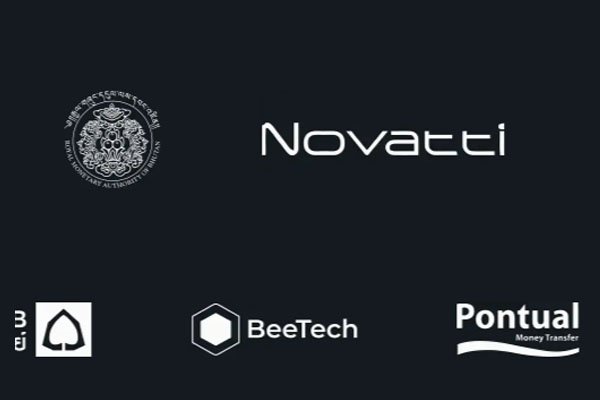
Blockchain Fintech: Blockchain for payments sounds straightforward, but the liquidity challenge has been the long pole in the tent to build and support.
The benefit there is the ease of use for developers, lower security risks, or risks of fat fingering something and making a mistake. We’ve read those painful news articles about mistakes in smart contracts that have painful results for a developer. Those are some of the benefits of how XLS-20 was designed. Because the XRP ledger is designed for highly efficient transactions at a high scale, gas fees are about $0.005.
I don’t want to let go of my $0.005. Maybe when I do an ETH transaction, I could spend 100 $0.005.
It sounds like a lot of DRC 1155. All the goodness and none are less of the fees and other inefficiencies there. It sounds like a step forward, and that’s where the vote needs to happen. Do you have a sense of a rough timeline based on the direction things are going now?
Because it’s this decentralized network of validators, it’s in their hands to vote on it. We’ll have to watch and see.
Once that happens, as far as promoting people’s interaction with it and use of it, do you have something on the roadmap there whereby that vote is a trigger and things start to happen on an XLS one?
We want to support developers and creators. In 2021, Ripple launched a $250 million creator fund to support creators building their projects on XRP Ledger. This XLS-20 standard has been available in DevNet for a number of months. Some have already been able to build what they’re building, and it’s ready to go with Mainnet acceptance if the validators do vote yes. We’ve had some cool projects. It’s fun to see the ideas that people submit. That’s probably some of what you saw at Ripple House in Austin, Texas.
We met the team behind XPUNKS and all the utilities that they’re embedding. We got him into the CoinDesk Consensus live podcast booth and did a little segment with him about XPUNKS. You’ll have to check that out on the show. I don’t know if they’ll release before or after this episode, but it’s a great example of folks putting the creator grant program and the technology platform that you’re offering into use.
They’re such a great team. I love their energy and creativity. We’re seeing a lot of different submissions on the creator fund. We also have launched a $1 billion XRP developer grants program that’s gone through a number of different ways. The first wave of grants that we awarded were mainly focused on NFT projects. We should also keep our eye out for some of those NFT Terrace, NFT Master, and ZerpCraft. There are some fun games and metaverse ideas that people are building. We’ll see those come out as well.
Going beyond the NFTs for a moment and speaking to some of your core customers like financial institutes, businesses, and governments, you mentioned a few projects, but is there anything else in your pipeline that you can talk about?
Given our heritage on the enterprise side and working with that bio for so long, we are engaged in a number of different enterprise use cases for NFTs that I find compelling. Real estate being one industry, both on the title side to clean up that very manual error-prone process, but also even democratizing access to real estate investing, as well as the carbon credits and markets use case is a compelling one. The challenges in carbon credit markets look similar to payments where you have a high degree of fragmentation amongst different carbon credit marketplaces.
You have poor and inefficient price discovery. You have the double-spend problem where people reuse carbon credits. We have a few different partners there where we’re supporting them to build their carbon credit marketplaces on the XRP Ledger exchange which is a powerful company that has the backing of the UN. We’re working on that. Those are a couple of the use cases. If you think of RippleNet, it’s a network of hundreds of different financial institutions. There are a lot of different use cases where we’ll see financial institutions veering into NFTs. We’re excited to also be partners on those.
I’m curious to wrap up the Q&A section with you on what inspires you outside of what you’re doing with Ripple when you look at the rest of the Web 3.0 NFT crypto space.
There’s so much. Every day, there are interesting things to read about. It’s such an incredible promise that tokenization and a combination of NFTs, but also using blockchain and cryptographic systems can solve. With your example at the top of the call of being a musician, if you’re a part of an informal economy, you’re still a part of an economy. You have an identity and credits that should be worth something.
To be able to translate that into a formal system that works around the world, there’s so much potential to bring those billions of people we read about who are excluded now, or that are underbanked, giving them access to financial services that will be transformative in terms of economic mobility over generations.
For those who are banked too, there is a lot of benefit to us where now, I feel that my data and identity are owned by Web 2.0 players. It would be compelling if I could take back ownership of my information and give delegated access to the entities that I approve when I approve it. I’m super psyched about that. It’s a huge problem to solve. I don’t specifically know which player has the right answer yet.
That’s huge. It’s like what I face every day, “Would you like to accept this cookie?” I go, “Somebody is taking little pieces of me, porting it around, and exchanging it.” There’s an interesting little note on that. It’s not necessarily a hot topic here, but some friends got a payout here in Illinois. Facebook was successfully sued for storing facial recognition data.
Apparently, there are laws that have been made in Illinois that do not allow you to store somebody’s biometric data specific types without their consent. Facebook did that without people’s consent. Multiple citizens won multiple hundred dollars. We’re talking about a lot of people. It’s a big lawsuit. There’s a similar one with Google going on as well.
Monica, it has been great learning more about all the amazing things happening at Ripple and how that intersects with our world of NFTs and all the good things to come. We’re very excited about what’s in store here in the coming months. I want to take a moment and transition to our second segment, which we call Edge Quick Hitters. It’s a fun, quick way to get to know you a little better. There are ten questions, and we’re looking for short, single-word, or fewer responses, but we may dive a little deeper here and there. Are you ready to jump in?
I’m on the edge of my seat.
Question number one, what was the first thing you remember ever purchasing in your life?
I was very diligent about saving as a kid. The random thing that pops to mind, I remember the pog phenomenon. Those are tokens. You play the game and you get the slammer, and you were trying to win. It’s like NFTs before Ts were digital. I remember investing in a whole book of different pogs and cool slammers.
Question number two, what is the first thing you remember ever selling in your life?
What it probably was were girl scout cookies or some fundraiser for a dance team I was on or whatnot. Those were some good lessons for an introverted little girl to go door-to-door and have to generate sales, and I got competitive about it. It was a good journey for me.
Question number three, what is the most recent thing you purchased?
It’s boring, but groceries.
Question four, what is the most recent thing you sold?
A table.
Was that Facebook Marketplace or Craigslist?
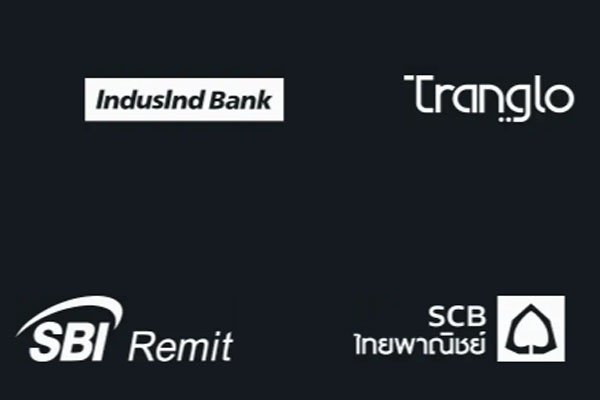
Blockchain Fintech: There are a lot of different use cases where we’ll see financial institutions veering into NFTs.
I have found Nextdoor to be the best platform for that activity. It’s for both end up finding the right thing and then also selling.
Question number five, what is your most prized possession?
I’m pretty good at purging things and getting things out the door. Something that I aspire to create, and hopefully sometime this 2022, is a garden in my yard. I’ve been intrigued by that. That will be a prized possession because the effort you have to put in and the learning curve of getting it right and the tip for it to bear fruit is going to be rewarding. I’m excited about that.
My wife has been working on a garden in our yard and it is very rewarding. We got vegetables and stuff for the first time as well. I did something which hopefully will turn out well, which I considered relatively much easier. I got a big bag of wildflower seeds and turned a bunch of ground, dumped them everywhere, and put some water on it. You just got to water it. I like the idea of wildflowers. It’s not it has to have some special protocols. There are these little tiny sprouts now. We’ll see. It might go nowhere.
Question six, if you could buy anything in the world, digital, physical, service, or experience that’s for sale, what would that be?
The posters behind me are the SpaceX posters trying to recruit people to colonize Mars. I’m not going up to Mars soon, but if in the remainder of my lifetime commercial space travel becomes something that feels relatively safe, that would be phenomenal. I’ll say space travel.
Space travel makes an appearance frequently throughout these questions, believe it or not. With that said, I believe Elon Musk when he said that the first trip is going to be very dangerous.
I’ll opt out for a while.
Question seven, if you could pass on one of your personality traits to the next generation, what would it be?
When I was a student, I like learning. I’m a curious person. That’s a good thing generally, and it’s served me well.
It’s one of those core values that works this way and almost any manifesto or core value statement that we have. Curiosity is important. On the flip side of that, if you could eliminate one of your personality traits from the next generation, what would that be?
Impatience. As a parent, I could be more patient. I always thought I could continue to work on that. As a business leader and as a friend, in all aspects of life, I could continue to try to improve on my patience.
Question number nine is a little easier. What did you do before joining us on the show?
I was in another meeting, and I drink a cup of coffee.
Question ten, what are you going to do next after the show?
I have another meeting. What I am looking forward to is picking up my kids at the end of the day of school. That’s always fun. They’re very small children so their storytelling of what they did for the day is all over the place, but it’s entertaining.
Separating truth from fiction is always a hard thing. That’s awesome. That’s Quick Hitters. Thanks so much for sharing with us. We appreciate it. The word on the street is we got a hot topic to talk about, a special one. Eathan, what do you say?
We’re going to bring somebody on here for a hot topic. He is the VP of Product at Animoca Brands, one of our wonderful friends and partners. I’m always happy to have a rep here from there. He’s going to talk to us a little bit about MotoGP Ignition Champions. I’ll throw it over to you, Sean, and give us a little bit of an intro of yourself. We heard you’ve been in the thick of it with Animoca forever, which is an awesome place to be. Tell us what you’re up to.
Thanks for having me on.
Thanks to Sean for being here.
We’re going okay. I have time to spruce up and shower to wake up. I’m good. As you mentioned, I’ve been at Animoca since Animoca was seeded from what its parent was, which was Outblaze. When we started in 2018, it is when CryptoKitties started to look at doing something in this space. We ran our own experiments. One of our biggest mobile games was Star Girl at that time. We minted some Star Girl NFTs. They’re still on OpenSea now if anyone wants to go and take a look at those. They’ve been around since 2018.
I’ve been with the company Animoca since it started through the blockchain stuff. What I do mostly now is I’m pretty hands-on with what we do with our REVV Motorsport ecosystem, which is essentially a motorsport racing gaming experience and ecosystem of games and anything that relates to not just racing but driving as well. We want it to be a far more all-encompassing experience. It includes a lot of IP as well.
We have you the same for the 1,000-plus Edge of NFT decked-out stylized race cars that are floating around in the world. I still have mine. I’m not selling that thing ever.
I liked those cars, but that delivery on those cars came together real good. That shock of pink is super eye-catching. It’s one of the cars I tend to drive around on. I was driving it because we had a test build coming, and it’s one of the cars that I have in my account there so I tested the latest balancing patch.
That’s a real game. It’s a challenging one as well. For me, the things I’ve seen from Animoca Brands and maybe some other companies that grew up in crypto versus cutting their teeth in pure gaming beforehand is there’s a big difference there. Some of the elements like the thoughtfulness in the game and the way that it challenges you are evident in the background of Animoca Brands.
It’s interesting that we are now in that space. We’re very fortunate that we have that background to leverage and the network that we have access to, where now it’s like, “Let’s make the user-facing aspect of this technology start to sink a little bit.” That’s far more interesting.
What’s cooking next? What can we expect with Ignition Champions and the timeline there for the card packs and all that good stuff? Break it down for us.
Ignition is our branded fully licensed MotoGP title that exists on Flow. We are launching Champions, which is essentially an NFT card-based. You can see it as an equivalent to fancy sports in some ways, but it utilizes all the NFTs that exist so far that we’ve pushed out for Ignition. It is a plan on title so people can participate and play. We’ll kick off three-day events and win a pool of REVV every three days. That’s going to kick off first, and that’s going to happen towards the end of the month.
Alongside that, as we have the platform for play available, we’re going to start looking to release more of the card packs. We have both our regular card packs lined up to go as well as what we call the hot shots, which are essentially video moments. They’re all playable within Card Champions. In a couple of months, when we launch the manager aspect of Ignition, they have utility over there too. All of this is connected through REVV. June 2022 is a super exciting month for Ignition.

Blockchain Fintech: Animoca Brands is now in that space where it’s like, “Okay, let’s make the user-facing aspect of this technology start to sink a little bit.”
You guys are always at the edge here. What are some of the innovations that are embedded in this release that you haven’t messed around with previously?
Flow is a big one. We’ve leaned very heavily into Flow. It has strengths and weaknesses. We released our decentralized marketplace and the REVV token on Flow. These are foundational for what we want to build as Animoca as a whole. That’s super important in aligning how we look at our software and technologies. Decentralization is super important to us.
As the marketplace contracts are built now, even though we support MotoGP NFTs, primarily because that’s where the marketplace exists and the REVV token, the contract is designed as such that it can support any NFT and any fungible as well. We’ve built it meaningfully to be that way so we can scope. Ideally, we do what we tend to want to do when we make everything open source and let everyone else go at it and build on top of this stuff.
Monica, I don’t know if you have any race car fans in your family, but what these guys have done with putting racing on the blockchain has been revolutionary.
I’m going to check it out.
Has Ripple and Animoca Brands had any meaningful intersection so far?
Sean, I think we share a partner in Forte.
I guess we do.
It’s a super quick ten-second on Forte. They’re an interesting company. They were so early. Ripple partnered with them in 2018. What they’ve built is a platform for game developers to create token economies in-game. The Founder and CEO, Josh Williams has a long storied history in gaming. He was the first person I talked to who talks about gamers having digital rights and ownership over in-game assets and things like property and land that felt very connected to that internet of value vision. They’re an exciting company to watch.
One of the things that they positioned themselves as at least is saying, “We’ll do the hard work on this, so you don’t have to figure this out.” The creators can come in and focus on building the games because Forte will provide this underlying infra of what the blockchain aspect is supposed to work and operate.
At the end of the day, Ripple is all about empowering the masses to bank and take that decentralized identity forward. Animoca Brands is doing a lot for bringing gaming to the next level of digital ownership as well and giving people a more customized experience with the things that they love to do. Gaming is no doubt a ubiquitous part of our society at this point in time and only growing day by day. It’s exciting to learn what you’re up to Sean. We can always work on the details later, but maybe we should have some fun giveaways for our readers out there with this project.
That call was pretty sweet. There’s always a bunch of other cool stuff we can do in addition to that.
Maybe NFT LA branded REVV racing car?
Never say never. We have a bunch of cool stuff.
We’ll keep an eye on your socials so we’ll come up with something fun in collaboration with Sean and the crew. I got to ask you too. I’m curious. Everybody over at Animoca Brands rocks that background. Is that a policy you guys have? Is that something you guys decided we’re going to do consistently over? They’re always curious about organizational decisions, and we’ve noticed that one pops up every single time.
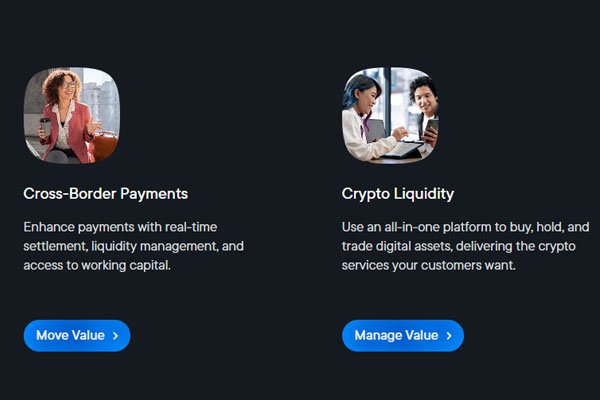
Blockchain Fintech: Forte is a really interesting company. What they’ve built is a platform for game developers to create token economies in-game.
It’s a nice way to showcase. When we say Animoca Brands, pinning down what it is, is weird. Sometimes at least with this banner, one of the things that it does that’s pretty important is that it displays our first-party studios. Although over the last year-plus, one of the biggest growth areas has been through our investments. That has become more and more important to us, and we’ve been able to make the right choices in that.
At our core, we’re builders and creators. That is showcasing all of these teams that are working on stuff inside Animoca to build the things that we believe in when it comes to blockchain, these decentralized products and ways to be creative in a more open ecosystem. These are all studios that are working on that stuff that worked directly with and through Animoca. We have to have it in some ways, but also there’s a little interesting reason for it as well as it says, “We’re more than this weird VC thing. We build our own stuff too.”
It makes sense. We’ve seen it a lot so we wanted to ask. One of the things too before we let you go, where should folks go to follow what you’re up to with everything?
Twitter is very important for us. It’s a great place for us to get feedback as well. The highest level @AnimocaBrands, do follow that. That’s where we announced everything that we do. For REVV racing and REVV Motorsports stuff, @REVV_Token on Twitter. From there, you can find the Discord channels, Telegram channels, and then the standalone Twitter handles for each one of the projects, which at the moment we’re going to be adding to since we wrapped up our acquisitions of the Grease Monkey Studio and Eden Games Studio.
Both of them are racing game studios. They’re building incredibly cool stuff and they’re super creative. Those are the big ones. Take a look at MotoGP Ignition Champions launches. REVV Play-to-Earn is going to be there. For some people, it might be their first exposure. If they didn’t jump in when Top Shot blew up, now’s a chance to get their hands on some Flow-based NFTs and marketplace action.
It sounds like you guys are doubling down on the racing genre, which is such an important part of the gaming experience. I did meet the team behind NASCAR at Consensus. They’re looking around trying to see what’s going on. I’ll have to put you in touch with them.
We work with Joey Logano. We wrapped up an event with Joey. He’s a superstar NASCAR driver. We did a fantastic event in REVV racing, and he went the extra mile and designed a circuit for us. There’s a circuit we call the Joey Logano Grand Prix. It’s one that he created. You go in there, and it’s very speedway-esque. That’s an incredibly cool thing that we were able to do with those guys.
Thanks so much for joining us on the program and sharing all the goodness that’s happening over there. We’ll catch up soon.
It’s a pleasure. Thank you very much.
Thanks, Sean.
Take care.
Monica, thank you for joining us for this entire episode. It was an amazing conversation. It has great insights. Our readers are going to be thrilled to learn from you. We wanted to make sure that everybody understands where to follow you and everything you’re up to with Ripple, as well as all the business happening on the Ripple side. Where should they go?
Twitter is a great, fast, easy, digestible, and real-time way to stay up to speed with Ripples. @Ripple handle probably is the most all-encompassing. If you’re in the NFT space, which most of your readers or all of them are, I would follow @RippleXDev, or you could follow me @MonicaLongSF.
We’ve reached the outer limit of the show. Thanks for exploring with us. We’ve got space for more adventures on the starship, so invite your friends and recruit some cool strangers that will make this journey also much better. How? Go to Spotify or iTunes, rate us, and say something awesome then head to EdgeOfNFT.com to dive further down the rabbit hole. Lastly, be sure to tune in next time for more great NFT content. Thanks again for being with us.
Important Links
- Ripple
- XRP Ledger
- Ripple House
- XPUNKS
- Liquidity Hub
- Animoca Brands
- MotoGP Ignition
- Outblaze
- CryptoKitties
- Star Girl NFTs
- REVV Motorsport
- Flow
- Forte
- @AnimocaBrands – Twitter
- @REVV_Token – Twitter
- Discord – REVV Motorsport
- Telegram – REVV Motorsport
- @Ripple – Twitter
- @RippleXDev – Twitter
- @MonicaLongSF – Twitter
- Spotify – Edge of NFT
- iTunes – Edge of NFT
About Monica Long

Leading the marketing team at Ripple, where we’re enabling instant, reliable and low-cost payments everywhere, every way, for everyone. Inspired by our mission? Let’s talk and see if there might be a place for you on the team: https://ripple.com/company/careers/

About Sean Dudley
Leading, creating, designing, and advising on blockchain games and experiences at Animoca Brands.
Launched numerous Web3 projects across the family of builders, collaborators, and partners.

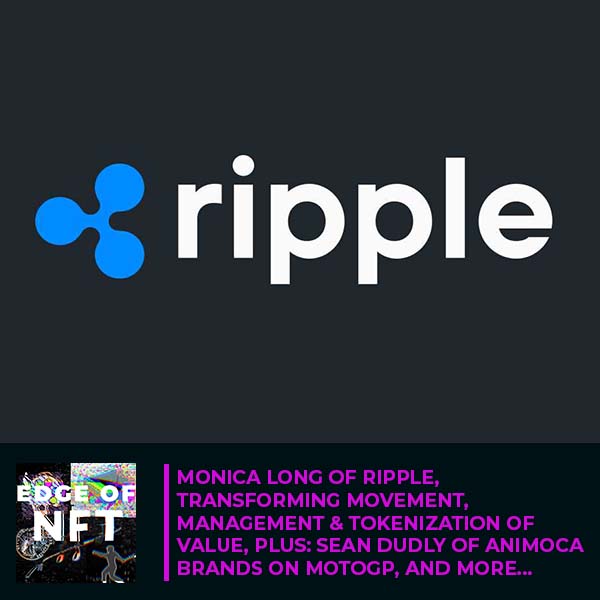
.jpg)

.jpg)
.webp)
.webp)
.webp)


.svg)









